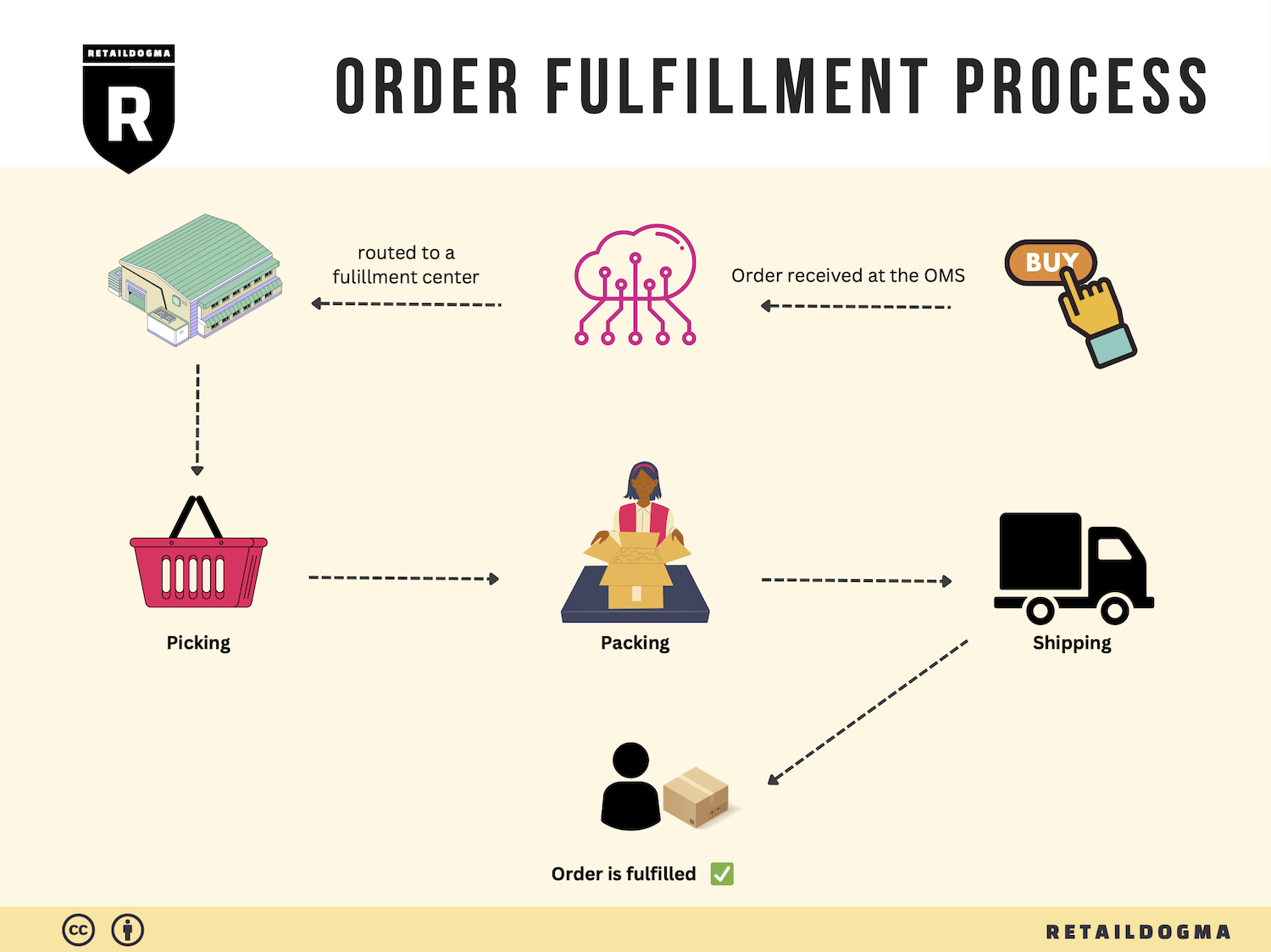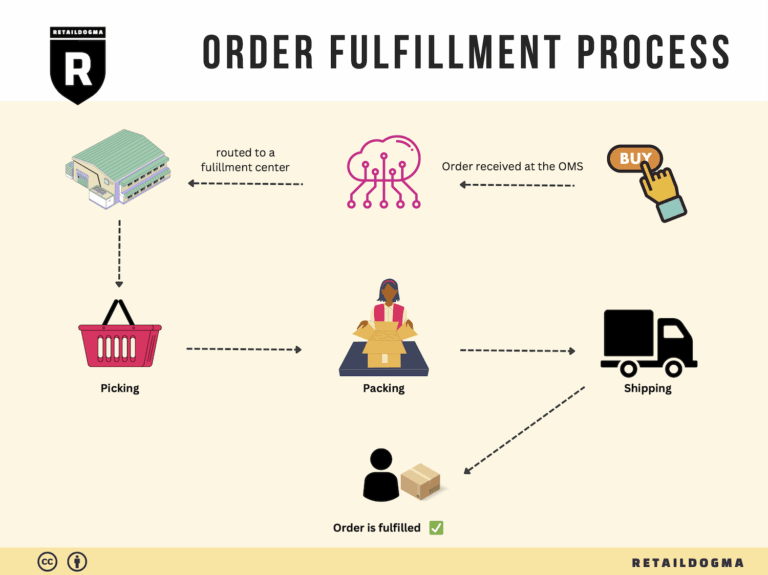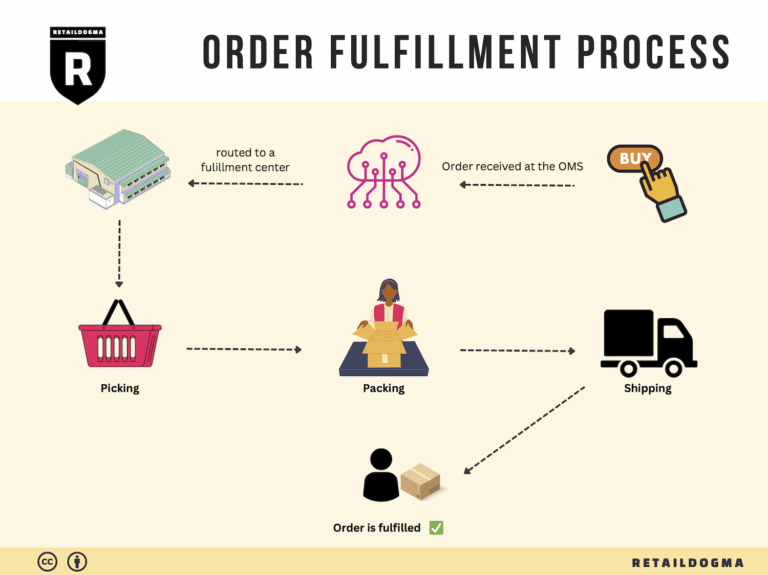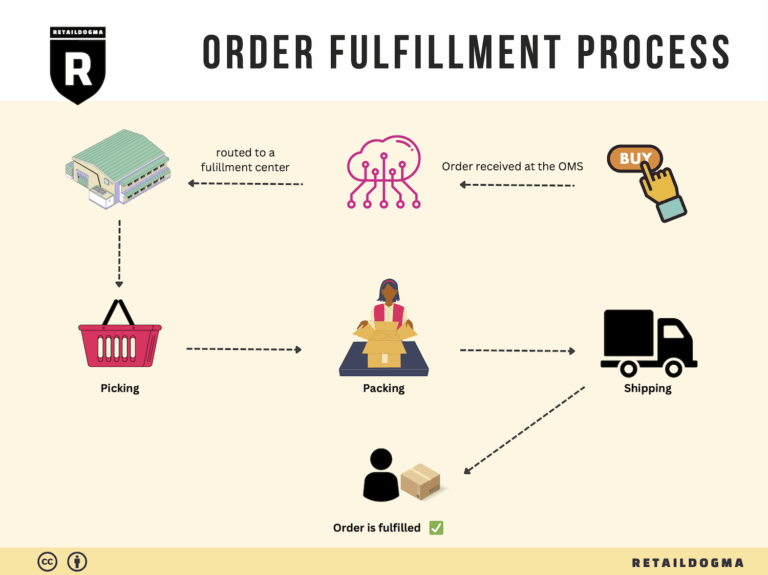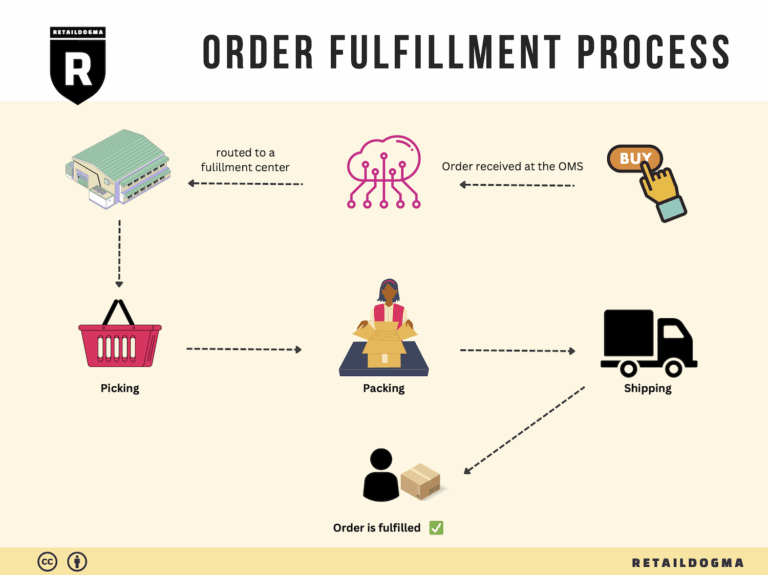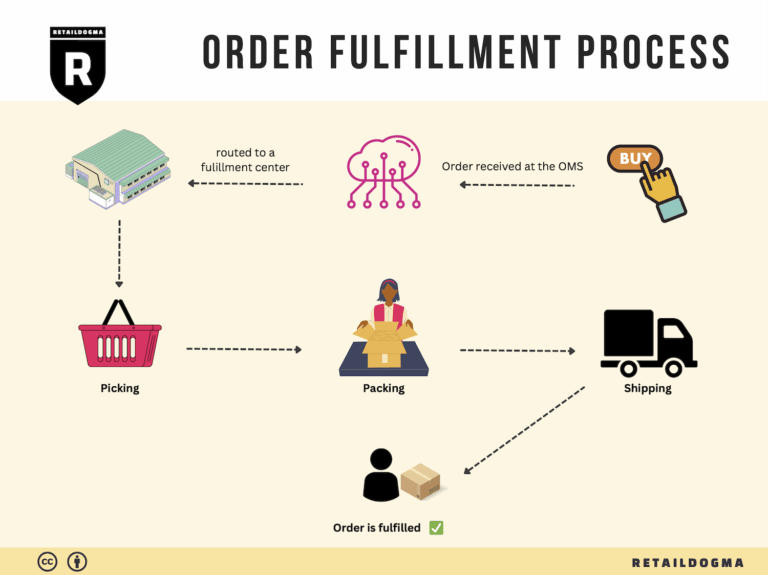How Order Fulfillment Works: A Step-by-Step Guide for Businesses
What is E-commerce Fulfillment? An Introduction for Growing Businesses
Understanding E-commerce Fulfillment: A Path to Streamlined Operations
As your online business begins to scale, you may find yourself grappling with the overwhelming tasks of packing and shipping orders. This is a common pain point for many e-commerce entrepreneurs. The excitement of increasing sales can quickly turn into stress as you juggle inventory management, order processing, and logistics, all while trying to maintain a high level of customer satisfaction. This is where e-commerce fulfillment comes into play.
At its core, fulfillment is the process of getting a product to a customer. It encompasses everything from receiving inventory to storing it, processing orders, and finally shipping the products to buyers. Efficient fulfillment not only ensures that your customers receive their orders on time but also helps you manage costs and optimize your operations.
In this guide, we will explore various fulfillment models to help you choose the right approach for your growing business. We’ll delve into popular options like Third-Party Logistics (3PL) and Fulfillment by Amazon (FBA), each with its unique benefits and challenges. Understanding these models will empower you to select a solution that aligns with your business goals and customer expectations.
Additionally, we will outline the core services provided by fulfillment partners. These services often include inventory management, order processing, packaging, shipping, and returns handling. Knowing what to expect from a fulfillment partner will help you evaluate potential providers and ensure that they can meet your specific needs.
Choosing the right fulfillment partner is critical to your success. We will provide practical tips on what to look for, such as reliability, technology integration, scalability, and customer service. This section aims to simplify the decision-making process, allowing you to focus on growth rather than logistics.
Finally, we will discuss pricing structures associated with different fulfillment models. Understanding the costs involved will enable you to budget effectively and avoid unexpected expenses, ensuring that your fulfillment strategy is both efficient and economically viable.
Our goal with this guide is to empower e-commerce business owners, operations managers, and entrepreneurs to make informed decisions about their logistics. With the right fulfillment strategy, you can transform your operations, enhance customer satisfaction, and ultimately drive your business toward sustained growth.

What You’ll Learn In This Guide
- What is E-commerce Fulfillment? An Introduction for Growing Businesses
- The Order Fulfillment Process: From ‘Buy’ Button to Customer’s Door
- Comparing Fulfillment Models: In-House vs. 3PL vs. Dropshipping
- A Deep Dive into Amazon FBA: Pros, Cons, and Who It’s For
- Core Services Offered by Fulfillment Centers
- How to Choose a Fulfillment Partner: A 6-Point Checklist
- Understanding Fulfillment Pricing: A Breakdown of Common Fees
- Frequently Asked Questions (FAQs) about Fulfillment
- Conclusion: Is Outsourcing Fulfillment the Right Move for Your Business?
- Important Disclaimer
The Order Fulfillment Process: From ‘Buy’ Button to Customer’s Door
1. Receiving Inventory
The first step in the order fulfillment process is receiving inventory at the fulfillment center. This involves checking incoming shipments against purchase orders to ensure accuracy and quality. Each item is assigned a Stock Keeping Unit (SKU), a unique identifier that simplifies tracking and managing inventory levels.
Importance: Proper inventory reception is crucial as it sets the stage for the entire fulfillment operation. Discrepancies at this stage can lead to stockouts, overstock, or even inventory loss, all of which can disrupt the supply chain and impact customer satisfaction. Efficient receiving processes help maintain accurate inventory records, which are essential for effective inventory management and forecasting.
Key Term: SKU (Stock Keeping Unit) – A unique identifier for each product that helps in inventory management and tracking.
2. Warehouse Storage
Once inventory is received, it must be stored properly within the warehouse. This involves organizing products in designated areas, often utilizing a warehouse management system (WMS) to optimize space and accessibility. Items are typically stored based on their SKU, with high-demand products placed closer to the packing area for faster access.
Importance: Effective warehouse storage is vital for maximizing space utilization and ensuring that products can be retrieved quickly when orders are placed. A well-organized warehouse reduces the time spent searching for items, which in turn decreases overall order lead times. Additionally, proper storage practices help prevent damage to products, ensuring they remain in sellable condition.
Key Term: Warehouse Management System (WMS) – A software application that helps manage warehouse operations, including inventory tracking, storage optimization, and order processing.

3. Order Picking
When a customer places an order, the next step is order picking, where items are retrieved from storage based on the order details. This process often utilizes pick lists—documents or digital displays that outline the items to be picked, their locations, and quantities. Picking can be done manually or through automated systems, depending on the size and complexity of the operation.
Importance: Order picking is a critical step that directly affects order accuracy and fulfillment speed. Errors during picking can lead to incorrect shipments, which can harm customer trust and result in costly returns. Implementing efficient picking methods, such as batch picking or zone picking, can enhance productivity and minimize errors.
Key Term: Pick List – A document or digital tool that guides warehouse staff in selecting the correct items for customer orders.
4. Order Packing
After items are picked, they are moved to the packing station, where they are prepared for shipment. During this step, items are inspected for quality, packed securely in appropriate packaging materials, and labeled for delivery. The packing process often involves verifying the order against the packing slip to ensure accuracy before sealing the box.
Importance: Packing is essential for protecting products during transit and ensuring that they arrive in good condition. Properly packed orders reduce the likelihood of damage during shipping, which can lead to customer dissatisfaction and increased return rates. Additionally, efficient packing processes can help streamline shipping operations and reduce costs.
Key Term: Packing Slip – A document that accompanies a shipment, detailing the items included in the package for verification by the customer.
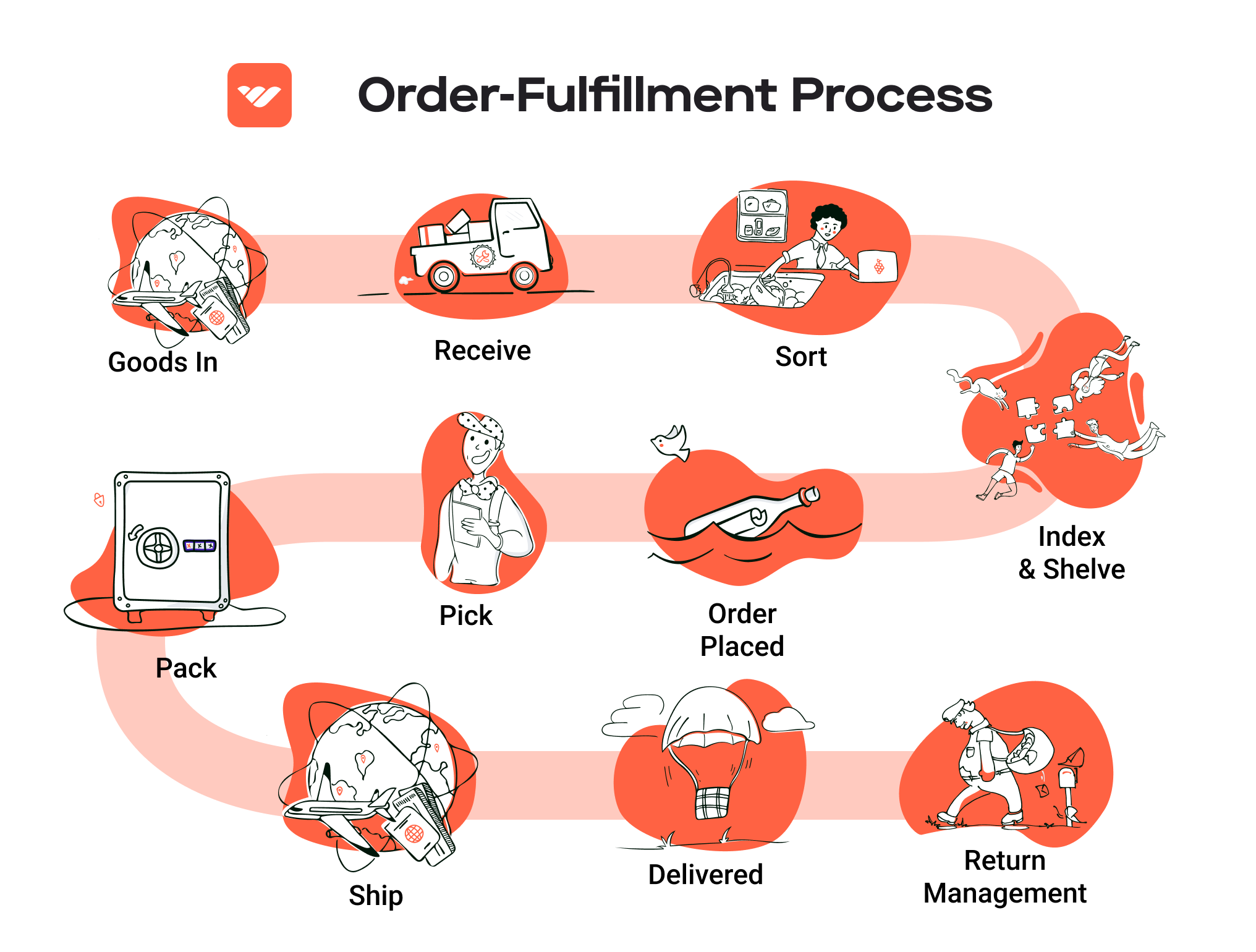
5. Shipping & Delivery
The final step in the fulfillment process is shipping and delivery. Once packed, orders are handed over to a shipping carrier for delivery to the customer. Businesses must select appropriate shipping methods based on cost, speed, and customer preferences. Tracking information is often provided to customers to keep them informed about their order status.
Importance: Timely shipping and delivery are crucial for customer satisfaction and retention. Delays can lead to frustration and negative reviews, impacting future sales. Businesses must work closely with shipping carriers to ensure reliable service and manage expectations effectively. An efficient shipping process can also enhance overall supply chain performance.
Key Term: Shipping Carrier – A company that transports goods from one location to another, responsible for delivering orders to customers.
By understanding and optimizing each of these steps, e-commerce businesses can enhance their order fulfillment processes, leading to improved customer satisfaction, reduced operational costs, and a more scalable business model.
Comparing Fulfillment Models: In-House vs. 3PL vs. Dropshipping
Fulfillment Model Comparison
| Model | Who Handles Inventory | Best For (Business Stage) | Key Advantage | Key Disadvantage |
|---|---|---|---|---|
| In-House Fulfillment | The business itself | Established businesses with stable sales | Complete control over operations | High overhead costs and resource commitment |
| Third-Party Logistics (3PL) | A third-party provider | Scaling businesses and startups | Flexibility and scalability | Less control over inventory and processes |
| Dropshipping | Suppliers | New businesses or those testing new products | Low upfront investment and risk | Lower profit margins and longer shipping times |
In-House Fulfillment
In-house fulfillment involves managing all aspects of storage, inventory, and shipping directly within your own business. This model is most suitable for established businesses that have stable sales volumes and can afford the associated overhead costs. One of the primary advantages of in-house fulfillment is the complete control it offers over inventory management, order processing, and customer service. This control allows businesses to customize their processes according to their specific needs, leading to potentially higher customer satisfaction.
However, the disadvantages are significant. Maintaining an in-house fulfillment operation requires substantial investment in warehouse space, staff, and technology. The ongoing costs can strain resources, especially for businesses that experience fluctuating sales volumes. Additionally, the operational complexity increases as the business scales, necessitating more sophisticated management systems and processes to handle growing demand effectively.
Third-Party Logistics (3PL)
Third-party logistics (3PL) providers manage all aspects of fulfillment on behalf of businesses. This model is particularly advantageous for companies that are scaling or for startups looking to minimize their initial investment. A key benefit of 3PL is the flexibility it provides; businesses can quickly adapt their logistics capabilities to meet changing demands without the burden of managing their own warehouses.
3PL providers also offer expertise in logistics, which can enhance efficiency and effectiveness in order fulfillment. They often have established systems and technologies that can reduce shipping times and costs. However, the trade-off for this convenience is a loss of control over inventory and fulfillment processes. Businesses may find it challenging to ensure quality standards are met or to implement changes quickly in response to customer feedback. Additionally, fees associated with 3PL services can accumulate, impacting profit margins if not managed carefully.
Dropshipping
Dropshipping is a fulfillment model where businesses sell products without holding inventory. Instead, when a customer places an order, the retailer purchases the item from a third-party supplier who ships it directly to the customer. This model is ideal for new businesses or those testing new products, as it requires minimal upfront investment and reduces the risk associated with unsold inventory.
The primary advantage of dropshipping is the low financial barrier to entry. Entrepreneurs can launch an e-commerce store without the need for significant capital investment in inventory or warehousing. This model allows for a broad product offering without the commitment of purchasing stock upfront. However, the downsides include lower profit margins, as suppliers often charge higher prices per unit. Additionally, shipping times can be longer, which may impact customer satisfaction. The reliance on suppliers for inventory availability and quality control can also pose risks, as any issues on their end directly affect your business’s reputation.
In conclusion, the choice of fulfillment model greatly depends on the specific needs and stage of your business. Each model offers distinct advantages and challenges, and understanding these can help you make informed decisions as you scale your e-commerce operations.
A Deep Dive into Amazon FBA: Pros, Cons, and Who It’s For
What is Fulfillment by Amazon (FBA)?
Fulfillment by Amazon (FBA) is a service provided by Amazon that allows e-commerce sellers to store their products in Amazon’s fulfillment centers. When a customer places an order for an FBA product, Amazon handles the logistics, including storage, packaging, and shipping, while also providing customer service and returns management. This service enables sellers to leverage Amazon’s vast distribution network and customer base, ultimately helping to scale their business without the overhead of managing their own warehousing and fulfillment operations.
When using FBA, sellers ship their inventory to Amazon’s fulfillment centers, where it is stored until sold. Amazon’s sophisticated inventory management system tracks the products, ensuring they are available for quick shipping. Once an order is placed, Amazon picks, packs, and ships the product directly to the customer. This process is designed to provide fast delivery and enhance the customer experience.
How FBA Works
-
Create an Amazon Seller Account: Sellers must first set up a professional seller account on Amazon.
-
List Products: Sellers create product listings, which can include descriptions, prices, and images.
-
Ship Inventory to Amazon: Sellers prepare their products and ship them to designated Amazon fulfillment centers. Amazon provides guidelines on packaging and labeling.
-
Storage and Management: Once received, Amazon stores the inventory. Sellers can monitor their stock levels through the seller dashboard.
-
Order Fulfillment: When a customer orders an FBA product, Amazon takes care of the entire fulfillment process, including picking, packing, and shipping.
-
Customer Service: Amazon handles all customer inquiries and returns for FBA orders, allowing sellers to focus on marketing and sales.
-
Payment: Sellers receive payments for their sales after deducting Amazon’s fees, which are typically based on the product category and size.
Pros of Using Amazon FBA
-
Prime Eligibility: Products fulfilled by Amazon are eligible for Amazon Prime, which can significantly boost sales due to the appeal of fast, free shipping to millions of Prime members.
-
Customer Trust: Amazon is a well-established brand known for its reliability. Using FBA enhances customer trust, as buyers feel more secure purchasing products that are fulfilled by Amazon.
-
Multi-Channel Fulfillment: FBA allows sellers to fulfill orders not just from Amazon but also from other sales channels, such as their own websites, thus providing a comprehensive logistics solution.
-
Time-Saving: By outsourcing storage, packing, and shipping to Amazon, sellers can focus on other critical aspects of their business, such as product development and marketing.
-
Scalability: FBA allows sellers to scale their operations quickly. As demand for products increases, sellers can easily send more inventory to Amazon without the need to invest in additional warehousing.
-
Robust Analytics: Amazon provides sellers with tools and analytics to track sales performance, inventory levels, and customer behavior, aiding in data-driven decision-making.
Cons of Using Amazon FBA
-
High Fees: FBA comes with various fees, including storage fees for holding inventory and fulfillment fees for picking, packing, and shipping orders. These costs can add up, particularly for sellers with low-margin products.
-
Strict Inventory Rules: Amazon has strict guidelines regarding inventory management. Sellers must adhere to these rules to avoid penalties, which can be challenging for those unfamiliar with the platform.
-
Commingling Risks: FBA products are often commingled with other sellers’ inventory. This means that when a customer orders a product, they may receive an item that belongs to another seller. This can lead to issues with quality control and brand integrity.
-
Limited Control Over Shipping: While Amazon handles the logistics, sellers have limited control over shipping times and methods, which can affect customer satisfaction.
-
Long-Term Storage Fees: Products that do not sell within a specific timeframe are subject to long-term storage fees, which can be a burden for sellers with slow-moving inventory.
Who is FBA Best For?
Fulfillment by Amazon is particularly advantageous for certain types of sellers:
-
Small to Medium-Sized Businesses: Businesses looking to scale quickly without investing heavily in logistics and warehousing can benefit significantly from FBA. It allows them to access Amazon’s vast customer base and distribution network.
-
E-commerce Entrepreneurs: New entrepreneurs who want to focus on product development and marketing rather than fulfillment logistics will find FBA to be an effective solution.
-
Brands with High Demand Products: Sellers with high-demand products can take advantage of the speed and efficiency of Amazon’s fulfillment network to meet customer expectations for rapid delivery.
-
Multi-Channel Sellers: Businesses that sell across multiple platforms (e.g., Amazon, eBay, their own website) can streamline their logistics by utilizing FBA for order fulfillment across channels.
-
Seasonal Sellers: Businesses that experience fluctuations in demand, such as during the holidays, can leverage FBA’s scalability to manage inventory effectively without the risk of overcommitting resources.
In conclusion, while Amazon FBA offers numerous benefits that can enhance an e-commerce business’s efficiency and sales potential, it is crucial for sellers to weigh these advantages against the associated costs and challenges. Understanding the nuances of FBA will empower sellers to make informed decisions that align with their business goals.
Core Services Offered by Fulfillment Centers
Inventory Management & Warehousing
Inventory management and warehousing are foundational services provided by fulfillment centers that enable e-commerce businesses to operate efficiently. Fulfillment centers utilize advanced inventory management systems to track stock levels in real-time, ensuring that businesses can maintain optimal inventory levels without overstocking or running out of products.
Benefits:
-
Real-Time Tracking: Fulfillment centers implement sophisticated software that allows businesses to monitor their inventory levels continuously. This capability reduces the risk of stockouts and enables timely reordering, which is crucial for maintaining sales momentum.
-
Space Optimization: By utilizing a fulfillment center, businesses can save on the costs associated with maintaining their own warehouses. Fulfillment centers are designed to maximize storage space, allowing for higher volumes of products to be stored efficiently.
-
Scalability: As businesses grow, their inventory needs can fluctuate significantly. Fulfillment centers offer scalable solutions, allowing businesses to expand their inventory without the need for significant capital investment in additional warehousing.
-
Cost-Efficiency: Leveraging a fulfillment center can lead to reduced overhead costs, as businesses do not need to invest in real estate, utilities, and staffing for their own storage facilities.
Pick and Pack Services
Pick and pack services are crucial for the efficient processing of customer orders. This service involves selecting items from storage (picking) and packaging them for shipment (packing). Fulfillment centers employ trained staff and automated systems to ensure accuracy and speed in these processes.
Benefits:
-
Accuracy and Speed: Fulfillment centers use barcoding and scanning technologies to minimize errors during the picking process. This accuracy ensures that customers receive the correct products, enhancing customer satisfaction and reducing return rates.
-
Time Savings: By outsourcing pick and pack services, e-commerce businesses can focus on core activities such as marketing and product development, rather than the logistics of order fulfillment. This allows for a more strategic allocation of resources.
-
Customized Packaging: Fulfillment centers can offer various packaging options to meet specific branding needs. This customization enhances the customer experience and can help businesses stand out in a competitive market.
-
Quick Turnaround: The efficiency of pick and pack operations in fulfillment centers means that orders can be processed and shipped rapidly, often within the same day. This speed is increasingly critical in today’s market where consumers expect fast delivery.
Kitting and Assembly
Kitting and assembly services involve the grouping of individual items into a single package or kit, often required for promotional offers or product bundles. This service can also include assembling products that require multiple components to be combined before shipping.
Benefits:
-
Streamlined Operations: Kitting reduces the time spent on order fulfillment by allowing multiple items to be packaged together in one step. This can lead to significant operational efficiencies, especially for businesses that frequently offer bundles or kits.
-
Enhanced Customer Offerings: By providing kitted products, businesses can create attractive offers that encourage larger purchases. This strategy can boost average order values and improve sales performance.
-
Reduced Handling Costs: When products are assembled or bundled at the fulfillment center, it minimizes the need for multiple shipments and reduces shipping costs. This can be particularly beneficial for businesses looking to optimize their logistics expenses.
-
Quality Control: Fulfillment centers often have quality control processes in place during kitting and assembly, ensuring that the final product meets the expected standards before it reaches the customer.
Returns Management (Reverse Logistics)
Returns management, also known as reverse logistics, is a critical service provided by fulfillment centers. This service encompasses the handling of returned products, from receiving them back to restocking or disposing of them appropriately.
Benefits:
-
Efficient Processing: Fulfillment centers have systems in place to quickly process returns, allowing businesses to minimize the impact of returns on their operations. Quick turnaround on returns can enhance customer satisfaction by ensuring that refunds or exchanges are handled swiftly.
-
Data Insights: Analyzing return data can provide valuable insights into customer behavior and product performance. This information can be used to improve product offerings, reduce return rates, and enhance overall customer experience.
-
Cost Management: Effective returns management can help businesses control costs associated with reverse logistics. Fulfillment centers often have established processes for evaluating returned items, determining whether they can be restocked or need to be discounted or disposed of.
-
Customer Retention: A smooth returns process can significantly improve customer loyalty. When customers know that they can easily return products, they are more likely to purchase again, confident in the retailer’s support.
By integrating these core services, fulfillment centers not only enhance operational efficiency but also provide substantial value to e-commerce businesses looking to scale. Leveraging these services allows businesses to focus on growth while ensuring that their logistics operations are handled by experts in the field.
How to Choose a Fulfillment Partner: A 6-Point Checklist
Location & Warehouse Network
Importance:
The geographical location of a fulfillment partner’s warehouses is crucial for optimizing shipping times and costs. A partner with strategically located warehouses can significantly reduce transit times to your customers, enhancing satisfaction and potentially lowering shipping expenses.
Questions to Ask:
– What are the locations of your fulfillment centers, and how do they align with my customer base?
– How do you determine the best distribution strategy for my products?
– Can you provide insights on your shipping rates based on different regions?
Technology & Integrations
Importance:
In today’s digital age, technology plays a pivotal role in the efficiency of supply chain operations. A robust fulfillment partner should offer advanced technology solutions that integrate seamlessly with your e-commerce platform, allowing for real-time tracking, inventory management, and order processing.
Questions to Ask:
– What fulfillment management software do you use, and how does it integrate with my existing systems?
– Can you provide real-time inventory updates and order tracking?
– How do you handle data security and compliance with data protection regulations?
Specializations (e.g., Cold Storage, Oversized Items)
Importance:
Not all fulfillment partners are equipped to handle every type of product. If your business deals with specialized items such as perishables requiring cold storage or oversized items that need specific handling, choosing a partner with the right expertise is essential to ensure product integrity and compliance with regulations.
Questions to Ask:
– Do you have experience handling products similar to mine, particularly in terms of storage and shipping requirements?
– What specialized services do you offer, such as climate control or packaging for fragile items?
– How do you ensure compliance with industry regulations for specialized products?
Scalability & Capacity
Importance:
As your business grows, so too will your fulfillment needs. A capable fulfillment partner should not only meet your current requirements but also have the capacity to scale operations efficiently as your business expands. This includes managing seasonal spikes in demand without compromising service quality.
Questions to Ask:
– How do you manage fluctuations in order volume, especially during peak seasons?
– Can you provide examples of how you’ve supported other clients during periods of rapid growth?
– What are your capabilities in terms of warehousing space and processing capacity?
Pricing and Contracts
Importance:
Understanding the pricing structure and contract terms of a fulfillment partner is vital for budgeting and financial planning. Transparent pricing models help avoid unexpected costs that can eat into profit margins. Look for partners that offer flexible contracts that can adapt to your changing business needs.
Questions to Ask:
– Can you provide a detailed breakdown of your pricing structure, including storage fees, shipping costs, and additional services?
– What are the terms of your contracts, and do you offer flexibility for scaling up or down?
– Are there any hidden fees or costs I should be aware of?
Customer Support & Reviews
Importance:
Effective customer support can make or break your relationship with a fulfillment partner. A responsive support team can help address issues quickly, minimizing disruptions in your supply chain. Additionally, checking reviews and testimonials from other clients can provide insights into their reliability and quality of service.
Questions to Ask:
– What customer support channels do you offer (e.g., phone, email, chat), and what are your response times?
– Can you provide references or case studies from businesses similar to mine?
– How do you handle issues or disputes that arise during the fulfillment process?
Conclusion
Choosing the right fulfillment partner is a critical decision for scaling your e-commerce business. By using this checklist as a guide, you can systematically evaluate potential partners based on their location, technology capabilities, specializations, scalability, pricing, and customer support. This thoughtful approach will help you align your operations with a partner that meets your business needs, ensuring efficient logistics and satisfied customers.
Understanding Fulfillment Pricing: A Breakdown of Common Fees
Initial Setup Fees
Initial setup fees are often the first financial consideration when partnering with a fulfillment center. These fees cover the administrative costs of onboarding your business into the fulfillment provider’s system. They may include account setup, integration with your e-commerce platform, and initial training sessions for using their software.
The calculation for initial setup fees varies between providers. Some may charge a flat fee, while others may base it on the complexity of your inventory or the number of integrations needed. It’s essential to clarify what is included in these fees and whether any ongoing support costs will arise after the initial setup.
Receiving Fees
Receiving fees are incurred when your products arrive at the fulfillment center. This fee covers the labor and equipment costs associated with unloading, inspecting, and storing your inventory. The rate can depend on various factors, including the volume of goods received and the complexity of the items (e.g., large or bulky products may incur higher charges).
Typically, receiving fees are calculated on a per-unit or per-pallet basis. For instance, a fulfillment center may charge a specific dollar amount for each pallet received, or a lower rate for individual items. Understanding how these fees scale with your inventory volume is crucial to budgeting effectively.
Storage Fees (per pallet/bin)
Storage fees are charged for the space your inventory occupies in the fulfillment center. These fees can vary based on the location of the fulfillment center, the size of your inventory, and the duration of storage.
Most fulfillment centers charge storage fees on a monthly basis, calculated per pallet or per bin. For example, if you occupy one pallet of space, you might be charged a monthly fee for that pallet. It’s important to note that some providers may have different rates for standard storage versus long-term storage (usually defined as items stored for more than six months). Businesses should monitor their inventory turnover to minimize long-term storage fees.
Pick & Pack Fees (per item/order)
Pick and pack fees are incurred each time an order is processed. This fee includes picking items from storage, packing them for shipment, and preparing them for delivery. The structure of pick and pack fees can vary significantly among fulfillment providers.
Typically, these fees are charged on a per-item or per-order basis. For instance, a fulfillment center may charge a set fee for the first item in an order and a reduced fee for each additional item. Some providers may also charge for special packing requirements, such as branded packaging or gift wrapping. Understanding the nuances of these fees is critical for accurately predicting order fulfillment costs.
Shipping Fees
Shipping fees are an integral part of fulfillment pricing and can greatly impact your overall costs. These fees cover the transportation of your products from the fulfillment center to the customer. Shipping fees can vary based on several factors, including the shipping method (standard, expedited, etc.), destination, package weight, and dimensions.
Many fulfillment centers offer discounted shipping rates based on volume, especially if they have partnerships with major carriers. Shipping fees may be calculated on a per-order basis or based on the total weight of the shipment. It’s advisable to compare shipping options and negotiate rates with your fulfillment provider to ensure you are getting the best deal.
Tips for Getting an Accurate Quote
-
Clarify Your Needs: Provide detailed information about your inventory, order volume, and specific requirements. This will help fulfillment providers give you a more accurate quote.
-
Request a Breakdown: Ask for a detailed breakdown of all fees, including any potential additional costs. This will help you avoid surprises later.
-
Compare Providers: Don’t settle for the first quote. Compare multiple fulfillment centers to understand the market rates and services offered.
-
Negotiate Terms: Be prepared to negotiate terms, especially if you have a high volume of orders or long-term commitments. Many providers are willing to offer discounts for larger volumes.
-
Monitor Performance: Once you’ve selected a provider, keep a close eye on the actual costs compared to the quoted fees to ensure you are staying within budget.
By understanding these common fees and strategically negotiating your fulfillment pricing, you can effectively scale your e-commerce business while managing costs.
Frequently Asked Questions (FAQs) about Fulfillment
1. What is the AZA5 Amazon Fulfillment Center?
The AZA5 Amazon Fulfillment Center is one of Amazon’s distribution facilities located in Phoenix, Arizona. It plays a crucial role in the logistics network by storing, packing, and shipping products to customers. This center is equipped with advanced technology and processes to ensure efficient order fulfillment.
2. How does the AZA5 center impact shipping times?
The AZA5 center helps reduce shipping times significantly for customers in the surrounding regions. By being strategically located, it allows for faster processing and delivery of orders, often within one to two days, especially for Prime members.
3. What services does the AZA5 Fulfillment Center offer?
The AZA5 Fulfillment Center provides various services including inventory storage, order processing, packaging, and shipping. It also handles returns and customer service inquiries related to the orders processed through this facility.
4. How does the AZA5 Fulfillment Center handle returns?
Returns processed through the AZA5 center are managed efficiently by utilizing Amazon’s return logistics system. Customers can initiate returns online, and the center is equipped to handle the rest, including restocking items and processing refunds.
5. What’s the difference between a warehouse and a fulfillment center?
A warehouse is primarily used for storage and may not be involved in order processing, while a fulfillment center specializes in storing, picking, packing, and shipping products directly to customers. Fulfillment centers are designed for high turnover and quick order processing.
6. What is a Third-Party Logistics Provider (3PL)?
A Third-Party Logistics Provider (3PL) is a service that manages logistics operations for other businesses, including warehousing, transportation, and order fulfillment. Amazon’s fulfillment centers, including AZA5, function similarly by providing these services to sellers on the Amazon platform.
7. How much do fulfillment services cost?
Fulfillment service costs can vary based on several factors, including the volume of orders, the size and weight of products, and specific services required. Generally, fees can include storage costs, pick-and-pack fees, and shipping charges. It’s essential to review pricing structures from providers to find the best fit for your business.
8. Can small businesses use the AZA5 Fulfillment Center?
Yes, small businesses can leverage the AZA5 Fulfillment Center through Amazon FBA (Fulfillment by Amazon). This program allows sellers to store their products in Amazon’s fulfillment centers and utilize Amazon’s logistics network for order fulfillment, providing small businesses with access to a vast customer base.
9. How do I get my products into the AZA5 Fulfillment Center?
To send products to the AZA5 Fulfillment Center, you must first create an Amazon seller account and enroll in the FBA program. Once enrolled, you can create shipping plans through your Amazon Seller Central account, which will guide you on how to prepare and ship your products to the AZA5 facility.
10. What technology is used at the AZA5 Fulfillment Center?
The AZA5 Fulfillment Center employs advanced technology, including robotics, automated sorting systems, and sophisticated inventory management software. These technologies enhance efficiency, accuracy, and speed in the order fulfillment process, allowing for a seamless customer experience.
Conclusion: Is Outsourcing Fulfillment the Right Move for Your Business?
Evaluating the Impact of Outsourcing Fulfillment
Outsourcing your fulfillment process can be a transformative decision for e-commerce businesses looking to scale efficiently. By leveraging a fulfillment service, companies can save significant time and resources, allowing them to focus on core business activities such as product development and marketing. Instead of managing inventory, packing, and shipping, your team can dedicate efforts to strategic growth initiatives, ultimately leading to improved operational efficiency.
Moreover, fulfillment services provide scalability that is often difficult to achieve in-house. As your sales increase or fluctuate seasonally, a capable fulfillment partner can adjust resources accordingly, ensuring that you meet customer demands without the overhead of maintaining a larger warehouse and staff. This flexibility is crucial in today’s dynamic e-commerce landscape, where consumer expectations for fast and reliable shipping continue to rise.
In addition to time and scalability, outsourcing fulfillment offers access to specialized expertise. Fulfillment providers bring industry knowledge and best practices that can enhance your logistics operations. From optimizing shipping routes to managing returns efficiently, these partners can help you navigate complexities that could otherwise hinder your growth.
However, the success of outsourcing fulfillment hinges on choosing the right partner. It’s essential to evaluate potential providers based on their capabilities, technology, and alignment with your business objectives. A strategic partnership can significantly impact your ability to scale effectively.
To determine if outsourcing fulfillment is the right move for your business, consider conducting a thorough audit of your current shipping and logistics processes. Identify bottlenecks, costs, and areas for improvement. This analysis will provide clarity on whether a fulfillment partner can help you achieve your growth aspirations and streamline operations. Start today, and take the first step toward a more efficient and scalable logistics solution.
Important Disclaimer
⚠️ Important Disclaimer
The information in this guide is for educational purposes. Fulfillment services, pricing, and platform features change frequently. Always conduct your own due diligence and consult with providers directly before making business decisions.
